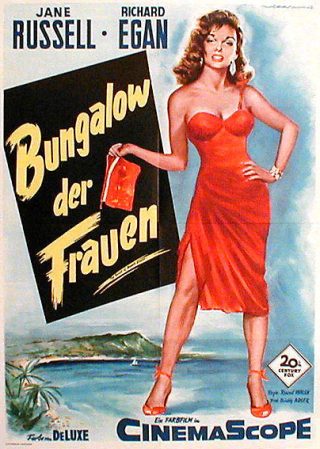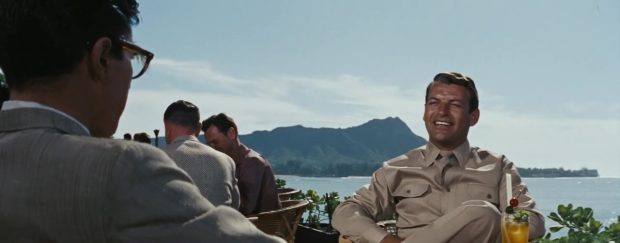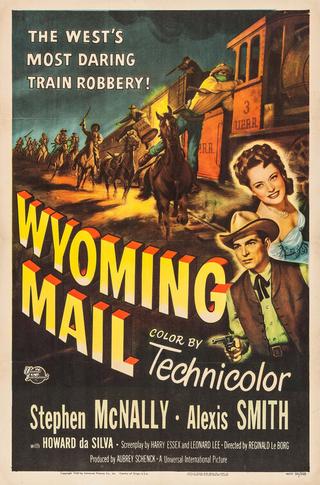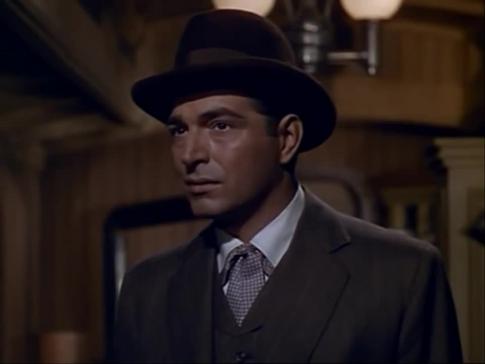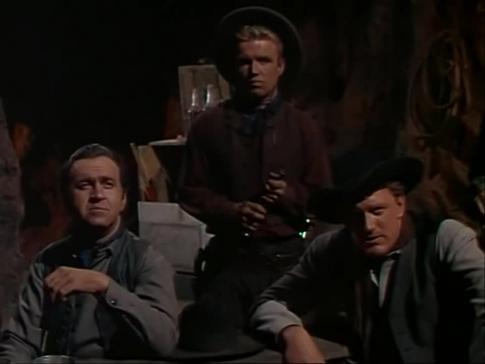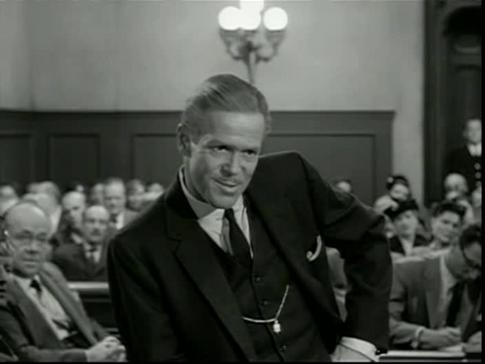I want to start by saying I have never read the book by William Bradford Huie which The Revolt of Mamie Stover (1956) is adapted from. In fact, it’s only recently that I had the opportunity to see the movie itself. I point this out because I understand some critics were displeased with the film on release due to its failure to stick as closely to the source as they would have liked. Yes, this is an area of discussion which has arisen before now on this site, and I imagine it will come up again. Personally, I am backing no horse in this race and am simply looking at the movie as a work of cinema in its own right.
It’s 1941 in San Francisco and the USA has yet to enter the Second World War. Mamie Stover (Jane Russell) is on her way to the docks to catch a boat to Honolulu and she’s headed there with an escort, a nice shiny police car is dropping her off and making sure she doesn’t miss the sailing. As Hugo Friedhofer’s sensually jazzy score kicks in, it is apparent that she has, in essence, been declared persona non grata by the authorities and invited to leave town. The reason is never spelled out, but the lewd references made about her on board, and of course her subsequent employment when she reaches her destination, imply that she is a prostitute of some notoriety. Speaking of destinations, this is an aspect which goes to the heart of the movie in many ways. The voyage to Hawaii sees Mamie making the acquaintance of Jim Blair (Richard Egan), a writer headed home to the islands after selling the rights to his book in Hollywood. In a sense, both of these characters are on their way home, although Mamie’s path there is the more circuitous of the two. There follows an almost inevitable shipboard romance and an equally predictable parting of the ways as soon as the ship docks. Jim is going back to his life high on the hill, with a well-bred girl (Joan Leslie) waiting for him. Mamie is off to work as a ‘hostess’ in the dance hall and clip joint run by Bertha Parchman (Agnes Moorehead). Just as surely as Jim and Mamie drift apart, fate’s long and winding road has it in mind for these two to meet again. With the storm clouds of war gathering, and their respective ambitions suggesting they have no business being together, the spark of attraction is still alive. However, with the bombing of Pearl Harbor and all that follows, they look to be taking separate roads again – Jim is off to war and Mamie seizes the opportunity to buy up as much property as she can afford at rock-bottom prices. And so it goes, back and forth for a while, patriot and profiteer drawn to each other by sheer animal attraction and yet always moving towards different destinations.
Raoul Walsh makes great use of the wide screen in The Revolt of Mamie Stover, switching between telling close-ups and carefully selected medium shots, only rarely crowding the frame and maintaining the intimacy of the story at all times. Leo Tover’s cinematography is frankly stunning, from the breathtaking backgrounds of the Hawaiian locations to the rich and sumptuous color in Bertha’s house of ill-repute. Sydney Boehm’s script is a characteristically strong one, keeping within the boundaries of the production code but still ensuring the adult themes are not watered down any more than necessary. A bit of reading around here and there tells me that the source novel presents more of a critique of society than the movie does. Not having read it, I can’t comment on that, but I can say that the focus of the film is very much on the people, on the individuals, how they grow and what they learn along the way, something which tends to make a film more involving.
Once again, Walsh defies his reputation as a macho director and demonstrates how well he dealt with films which placed women right at the heart of the story. The melodrama that drives it all is liberally laced with humor, both broad and subtle, and there is a distinctly humanistic feel to the way the characters are drawn and observed. Neither Walsh nor Boehm are interested in handing out some trite moralistic message. The movie looks at people, warts and all, neither excusing nor explaining them, and the ending, in that classically cyclical fashion, brings us right back to the point where it all began, but the crucial difference is that these characters whose lives have been traced on the screen have grown and developed.
Jane Russell was making some varied and interesting movies around this time, including The Tall Men (also for Walsh) and Foxfire. However, she was soon to move to television and only later drift back to the movies for a cameo playing herself in Ralph Nelson’s rather good Fate is the Hunter and then a couple of pretty depressing A C Lyles westerns. Mamie Stover offered her a good part as a woman juggling her love for money and material success with her love for Jim Blair, and winning something entirely different and unexpected in the end. Richard Egan brings a tough confidence to his role, and achieves a quiet dignity that is very admirable in the climactic scene. Agnes Moorehead is a highlight as the cunning and hard as nails proprietress, displaying as much burnished brass as her startlingly blonde hair. Joan Leslie was another who was about to move to television after a long and successful career on the big screen but, like her character, she is largely sidelined. And last but not least, Michael Pate scowls most effectively as the bespectacled thug using heavy-handed tactics to keep Bertha’s girls in line.
The Revolt of Mamie Stover was handed a Blu-ray release some years ago by Twilight Time. I never managed to pick up a copy and I don’t believe it has come out anywhere else on that format. However, there are copies to be had from Spain, not ideal copies but watchable enough and in the correct aspect ratio. It took me a long time to catch up with this film and I enjoyed seeing it at last. Walsh, Tover and Boehm combine well behind the cameras, and the cast doesn’t disappoint in front either. This is an entertaining and grown-up movie that sidesteps the typical sugar-coated Hollywood ending yet still manages to tie everything up very satisfactorily.
